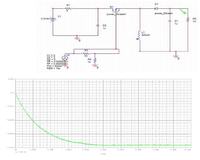ohm77
Newbie level 4
- Joined
- Aug 9, 2012
- Messages
- 6
- Helped
- 0
- Reputation
- 0
- Reaction score
- 0
- Trophy points
- 1,281
- Location
- montreal,canada
- Activity points
- 1,327
Hi all,
I'm working on a buck-boost converter (DC/DC), the specifications are: for 0.5V in the input I must have 3v in the output, and for the amplitude of oscillations that excite the grid of the transistor NMOS it must be less than 3v (the output voltage).
My problem is that when I give to the amplitude of oscillations 2.5v (that exite the grid of NMOS) it affects the output of the converter thus I get 1V at the output of my converter.
My question is: How can I get 3V in the output of the converter, and have an amplitude of oscillation less than 3v to excite the grid of the NMOS?
thank you.
I'm working on a buck-boost converter (DC/DC), the specifications are: for 0.5V in the input I must have 3v in the output, and for the amplitude of oscillations that excite the grid of the transistor NMOS it must be less than 3v (the output voltage).
My problem is that when I give to the amplitude of oscillations 2.5v (that exite the grid of NMOS) it affects the output of the converter thus I get 1V at the output of my converter.
My question is: How can I get 3V in the output of the converter, and have an amplitude of oscillation less than 3v to excite the grid of the NMOS?
thank you.

